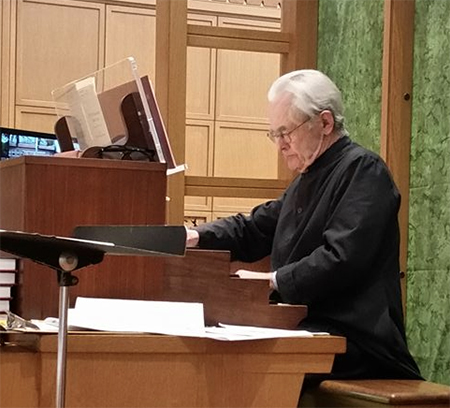by Timothy Robson

In collaboration with Cleveland-based saxophonist Noa Even, Paukert opened Ars organi II on Sunday afternoon, September 29 with several new pieces, as well as organ works from the 20th century that stand as classics alongside brand-new compositions. Even and Paukert were a well-matched pair both technically and musically. The combination of saxophone and organ proved to be extremely attractive.
Czech composer Jiří Treml composed Three Pieces for Organ (Fantasia, Responsoria, Toccata) in 2012 for Paukert in a severely modernist style, with strong dissonances, short motivic passages, and jabbing chords alternating with more lyrical moments. The “Responsoria” was especially effective, with floating clusters on the Holtkamp organ’s string stops, and occasional references to Gregorian chants. Like French organ toccatas, Treml’s last movement features streams of fast notes, syncopated rhythms with repeated patterns, and a melody played by the pedals. Paukert’s virtuosity was on display in this triptych. His grasp of the work’s technical demands as well as his panache made these an effective and dramatic musical experience.

Video might have drawn the composer’s inspiration closer together with the work’s composition and execution. During the performance, the saxophone plays a series of long tones at various pitches, registers, and dynamics. Even’s sound was rich and full, and she had excellent control over the dynamic range of the various notes. Her performance was akin to performing some minimalist music — the difficulty is not necessarily in the notes themselves, but in maintaining the concentration to fold the elements into a unity. The electronics then respond to the notes played live by creating other notes at various pitches and registers, creating a moody and atmospheric effect.
Alan Stout taught for many years at Northwestern University. In 1969 he published a collection of chorale preludes for organ based on Lutheran chorale tunes. Paukert played two of them, Christ lag in Todesbanden and Nun ruhe alle Wälder. In each, the chorale melody is clearly laid out on a solo organ stop, with a dissonant, almost atonal, accompaniment. Fifty years later, the preludes are still disconcerting to hear — perhaps because of our very tonal associations with other chorale preludes — but the settings draw into focus the texts of the hymns on which they are based.

Karel Paukert followed up McDaniel’s premiere with two short works by the twentieth-century French composer Jehan Alain, who died while serving in the French army during World War II. Although he was only 29 at the time of his death, his works show remarkable originality in form and harmony, with polytonality, complex rhythmic structures, and unusual combinations of organ timbres.
The brief Ballade en mode phrygien features a mournful melody, often accompanied by only one or two voices. Paukert made these phrases sing. He also explored unusual tonal combinations of the organ, effectively realizing Alain’s idiosyncratic registration indications. The much more substantial Deuxième fantaisie is based on an opening theme that recurs throughout the development of the piece in increasingly complex garb, until it reaches a massive, swirling climax. A fanfare-like statement of the theme precedes a final coda, drawing the Fantasie to a soft close.
Set in contrast with the new works on this program, Alain’s works show how much he was in the vanguard of his time, and foreshadow what he might have accomplished had he survived. A few finger slips aside, Karel Paukert’s performance of the Deuxième fantaisie was musically thrilling. Well-paced, its many sections flowed from one to another as a single thought.

Published on ClevelandClassical.com October 2, 2019.
Click here for a printable copy of this article



